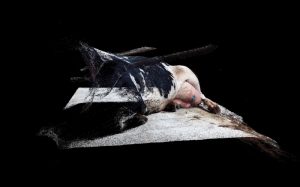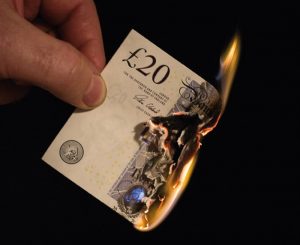Animals that fake their appearance to blend in their surrounding and attract their prey, people who fake a delirious state of bliss on social media, girls who prefer fake fur (or ‘fantasy fur’ as Lagerfeld called it) to the real one, etc. Sometimes the fake is just a little bit more desirable than the real. And if you’re worried about animal welfare, broken food systems and the future of our planet, then fake meat, and in particular lab-grown meat, looks like the saviour humanity was waiting for. It will be cruelty free, greenhouse gases free and guilt free. At least that’s the promise.
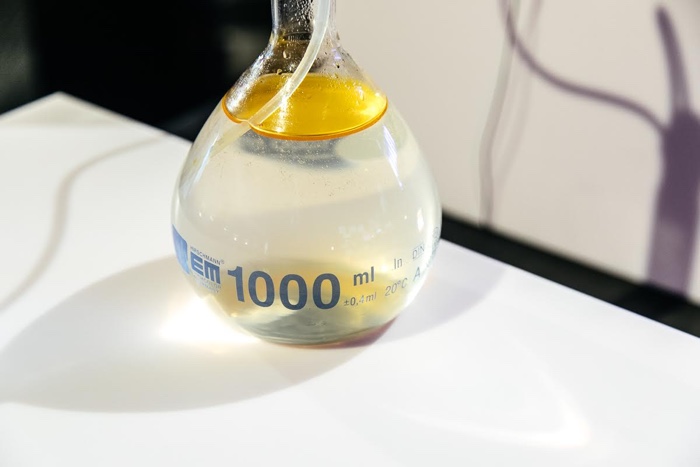
Devon Ward and Oron Catts, Vapour Meat [HP0.3.1]alpha, 2018. Exhibition view. Image courtesy of the Science Gallery at Trinity College Dublin
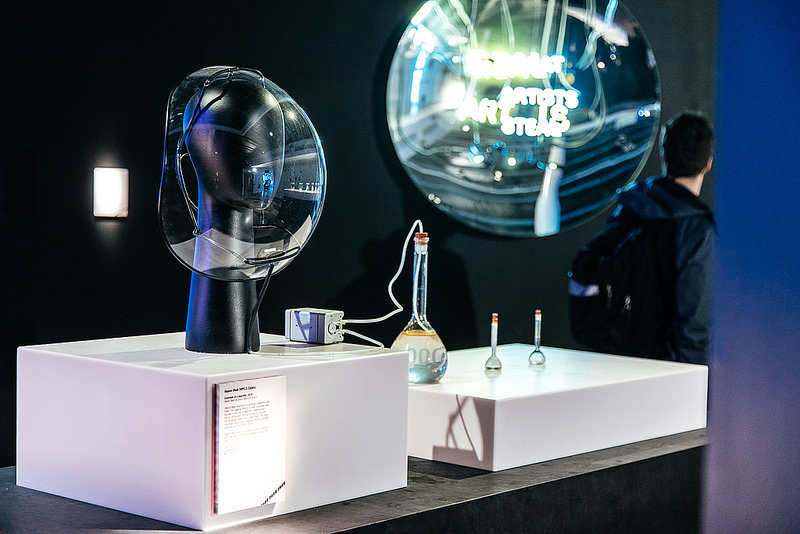
Devon Ward and Oron Catts, Vapour Meat [HP0.3.1]alpha, 2018. Exhibition view. Image courtesy of the Science Gallery at Trinity College Dublin
Technological solutions like lab-grown meat come with ethical, ecological and economic costs that receive far less coverage in the press than the cheerful myths and fictions heralded by the proponents of the technology. As previous works by The Tissue Culture & Art Project have demonstrated time and again (from Disembodied Cuisine which pioneered the lab-grown meat practice to Stir Fly, a bioreactor designed to culture and farm in vitro insect meat at home), one of the most contentious aspects of tissue engineering is its use of fetal bovine serum as a nutrient for the cells. Harvested from unborn calves, usually by drawing the blood directly from the heart of the fetus after the pregnant mother is slaughtered, FBS enables the cells to grow and multiply into meat for our consumption.
There are plant-based alternatives to the FBS of course but their content and formulation is wrapped in IP claims, NDAs and secrecy. And if there’s one thing our food systems need almost as much as the eradication of cruel practices, it’s transparency. This fake meat lack of transparency is reflected in the language adopted by the industry: they talk of “clean meat” and of “cellular agriculture”, for example.
Besides, growing cells in this way is also grossly inefficient. It requires considerable amount of resources and engineering on several levels: replicating the experience of eating meat is not just a question of aspect and taste, it also involves the reproduction of the meat texture, elasticity, smell, etc.
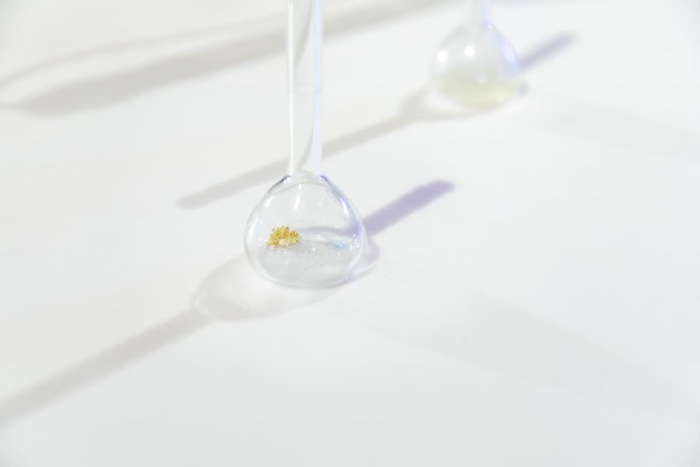
Devon Ward and Oron Catts, Vapour Meat [HP0.3.1]alpha, 2018. Exhibition view. Image courtesy of the Science Gallery at Trinity College Dublin
Vapour Meat, by Devon Ward and Oron Catts tries to unpack the growing uneasiness with meat and the murkiness that surrounds its artificial duplicates. The work pushes the discourse around lab-grown meat to its most extreme limits by imagining a device that would enable meat lovers to vape the essence of lab-grown meat.
Vapour Meat casts a critical and sarcastic eye at an industry typified by eco-opportunism and a love for the techno fix (why stop eating meat and consume plant-based proteins when you can throw a bit of science on a problem?) Ward and Catts see lab-grown meat as a kind of vapourware, a term used in the computer industry to design a computer hardware or software product that is announced to the general public but is never actually manufactured nor officially cancelled. Which is pretty much what is happening with in-vitro meat, a technology that has been described as ‘just around the corner’ for years. Yet, it remains unclear how the technology will be scaled up beyond prototypes or how it will comply with appropriate safety standards and relevant regulations across nations.
Vapour Meat is an example of what Catts and Ionat Zurr call a work of contestable design. Instead of evoking the desirable objects and scenarios typical of speculative design, contestable design submits to public scrutiny scenarios that underscore future problematic uses of a technological or scientific process.
FAKE: Faux or no? at Science Gallery Dublin
Vapour Meat uses this scenario to posit a future in which we reach for the fake and the technological in lieu of the real. As such, it’s one of the most interesting and curious works you can see at FAKE: The Real Deal?, a free exhibition at the Dublin Science Gallery that asks if life is better when we embrace the artificial.
I’ll come back with a long and proper review of the show later on. In the meantime, i got in touch with Devon Ward to learn more about Vapour Meat:
Hi Devon! What’s in the vapour that makes it smell like meat? How did you develop this artificial smell?
The vapour is composed of a mixture of different essential oils, infused oils and spices. I used my home cooking as the starting point to develop the smell. Many of the elements are based on spices I use when cooking. Without giving too much away, the vapour liquid contains infused oils that include flavours like smoked paprika and cumin. There are also small amounts of essential oils including sandalwood and basil, which aim at a mixture of smoky and sweet.
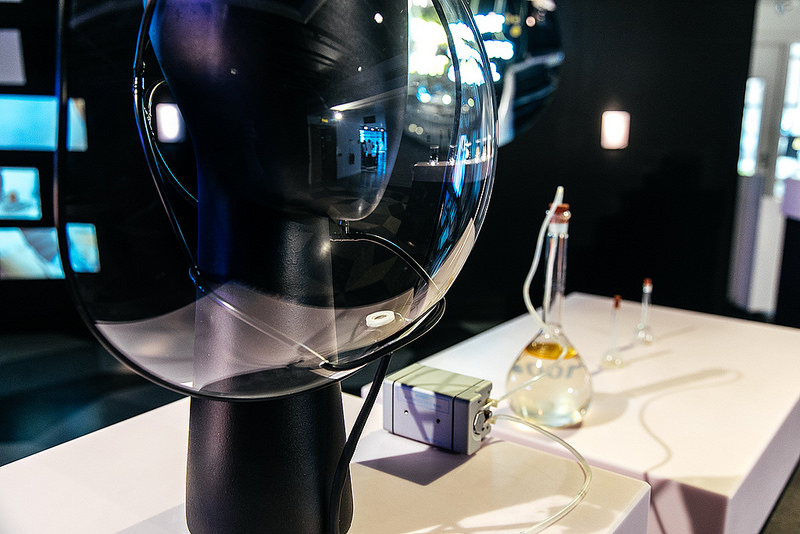
Devon Ward and Oron Catts, Vapour Meat [HP0.3.1]alpha, 2018. Exhibition view. Image courtesy of the Science Gallery at Trinity College Dublin
On the one hand, the work might also be seen as a demonstration of the absurdity and excesses of the whole synthetic and lab grown meat industry that requires so much efforts, technology and artifices in order to produce proteins that could be found elsewhere, in a ‘natural’ state. So how does a work like Vapour Meat position itself within the fake meat issue?
You’re right, Vapour Meat isn’t too far from what companies may soon be producing. We may see ‘clean’ meat products that adopt sophisticated food presentation techniques to sell in vitro meat to a niche market. I wouldn’t be surprised if these companies create products inspired by Rene Redzepi or David Chang. For instance, labs may start serving ‘clean’ rabbit caviar on a bed of locally sourced arugula topped with owl mousse and a GFP-infused salt. And if a waiter served it, I can almost hear them saying something like, “this dish is a taste of our current cultural moment. It gives you the flavour of our biotech terroir, something lab-crafted and home-grown, at the same time. It’s a lab-to-table experience…” We may even see products that reference Marinetti’s Futurist Cookbook. Someone might make a dish based on his Chickenfiat, a dish made of chicken and ball-bearings. The ‘Clean’ Chickenfiat recipe might call for in vitro chicken cells grown over the surface of steel ball-bearings served in a Martini glass while you sit in the cockpit of a VR flight simulator with LCD windows that display an orbit around Jupiter. All of this is to say that we may see elaborate spectacles being employed in order to sell ‘clean’ meat. The ‘clean’ meat industry wants to replace farm-grown meat with lab-grown meat, but it may just end up creating high-end products that only a few people can afford. The individuals pushing these grand visions seem to really gravitate toward highly technical fixes. This idea was dealt with by Oron Catts and Ionat Zurr in works like Disembodied Cuisine and Victimless Leather. And, Oron wrote an article for The Conversation last year that tries to unpack the hype-cycle around the lab-grown meat.
Vapour Meat definitely builds off of these ideas. The way I see it, Vapour Meat is a critical piece that satirises the recent cultural developments around lab-grown meat. It attempts to draw parallels between the ails of start-up cultures and the ‘clean’ meat industry.
The name Vapour Meat was inspired by the term vapourware, which describes software that is heavily hyped in order to draw interest and investors, but which never delivers on its promises. In other words, vapourware is something that deals with marketing, speculation, ideal and utopia. The term seemed utterly relevant, so Oron and I developed Vapour Meat to explore the overlaps between vapourware and ‘clean’ meat. We created an absurd product that literally produces nothing but vapour, but attempts to convey the ‘essence of meat’ through smell and small quantities of desiccated mouse muscle fibres (C2C12s). The work seemed to critically engage with the big promises of the ‘clean’ meat industry—namely that it will replace animal farming and dramatically reduce greenhouse emissions. Could ‘clean’ meat theoretically solve major issues around animal farming? Sure, but I have trouble seeing ‘clean’ meat live up to its grand ideals. There may be a place for in vitro meat in the future, but it may just be another signifier of status, power and wealth. ‘Clean’ meat may just be a form of conspicuous consumption.
And why does the title also feature “HP0.3.1 Alpha”? What does this correspond to?
“HP0.3.1 alpha” comes from software development nomenclature, which includes a code name, version number, and development stage. It’s a bit of an Easter egg for anyone working with software. In general, because we wanted to explore the overlaps between software start-up culture and biotech start-up culture, the nomenclature was another way to communicate that connection.
The “HP” stands for homeopathic. We were unable to include in vitro meat cells in the liquid reservoir for health and safety reasons, so this reality became the code name for our project. The “0.3.1” is due to the fact that work at the Science Gallery Dublin is actually the third version. Vapour Meat was in development for a year and previous versions involved other artists, so we thought this was a fitting way to acknowledge their involvement. We labelled this version of the work “alpha” due to the fact that it’s still being developed further. Also “alpha” is used to designate “white-box testing,” which was appropriate for a gallery exhibition.
Thanks Devon!
The exhibition FAKE: The Real Deal? remains open at the Science Gallery at Trinity College Dublin until the 3rd of June 2018.




